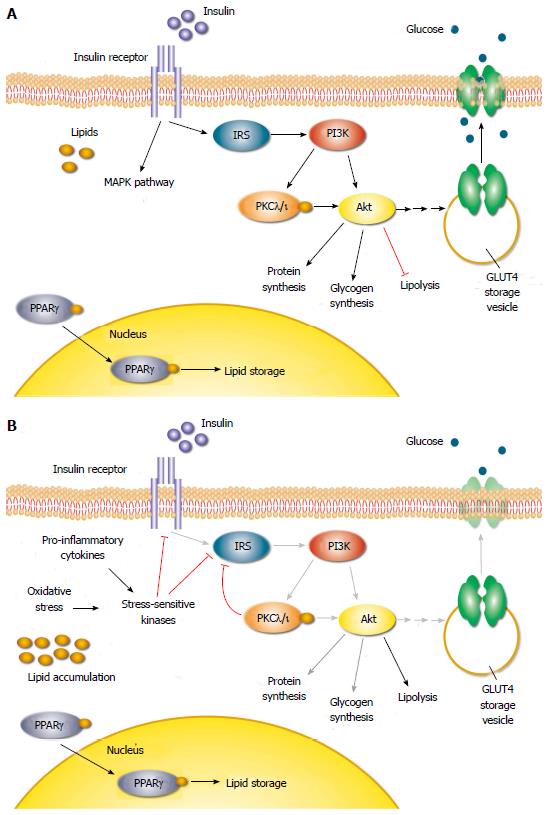Copyright
©2014 Baishideng Publishing Group Co.
World J Diabetes. Apr 15, 2014; 5(2): 146-159
Published online Apr 15, 2014. doi: 10.4239/wjd.v5.i2.146
Published online Apr 15, 2014. doi: 10.4239/wjd.v5.i2.146
Figure 2 Insulin signaling in health and disease.
Insulin signaling in health and disease. A: The binding of insulin to its receptor triggers a cascade of cellular events that lead to nutrient uptake and activation of various cellular programs. Insulin receptor substrate (IRS) activates phosphoinositide 3-kinase (PI3K) which produces a metabolite that activates protein kinase B (AKT) and protein kinase C λ/ι (PKCλ/ι). PKCλ/ι, which also depends on lipids for activation, can inhibit insulin signaling by a feedback mechanism. The nuclear receptor peroxisome proliferator-activated receptor gamma (PPARγ), is important in lipid metabolism, and is the target of insulin sensitizing thiazolidinedione drugs. PPARγ becomes activated upon binding of lipids and promotes expression of genes involved in fat storage; B: Under insulin-resistant conditions, accumulation of lipids, oxidative stress, and pro-inflammatory cytokines cause activation of stress-sensitive kinases such as protein kinase C θ ( PKCθ), inhibitor of nuclear factor kappa-B kinase subunit β (IKKβ) and c-Jun N-terminal kinase 1 (JNK1), which inhibit insulin signaling.
- Citation: Bunner AE, Chandrasekera PC, Barnard ND. Knockout mouse models of insulin signaling: Relevance past and future. World J Diabetes 2014; 5(2): 146-159
- URL: https://www.wjgnet.com/1948-9358/full/v5/i2/146.htm
- DOI: https://dx.doi.org/10.4239/wjd.v5.i2.146









